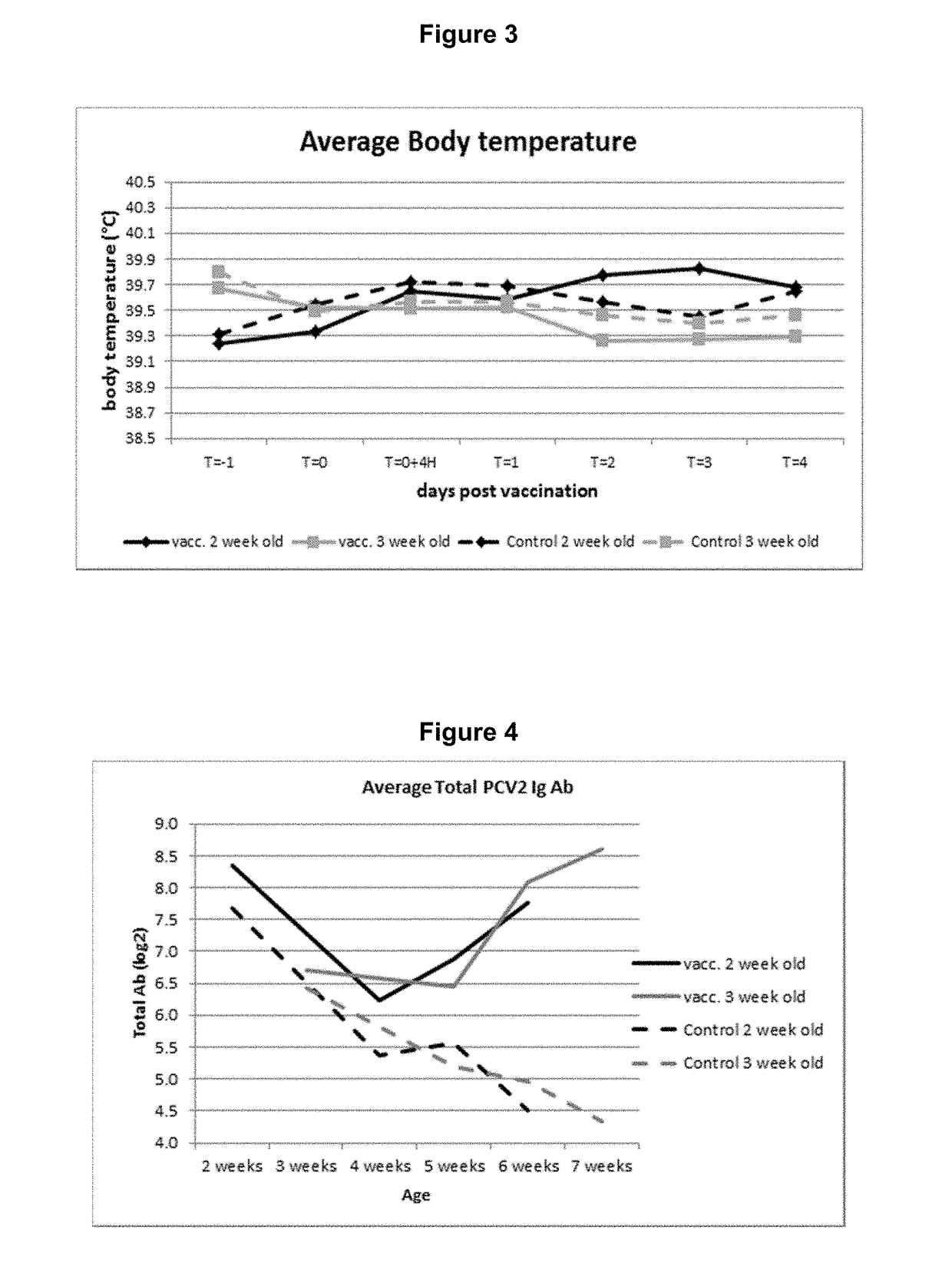Vaccine against porcine circo virus type 2
a porcine circo virus and vaccine technology, applied in the field of vaccines against porcine circo viruses type 2, can solve the problems of not being particularly configured for intradermal application, device, needle-less, etc., and achieve the effect of convenient use and little or no systemic side effects
- Summary
- Abstract
- Description
- Claims
- Application Information
AI Technical Summary
Problems solved by technology
Method used
Image
Examples
example 1
[0057]Experimental Design
[0058]Progeny of 10 sows with antibodies against PCV2 were used for this study. Piglets were divided across litters into 2 groups of 15 animal animals. At 3 weeks of age, the piglets of group 1 were vaccinated intradermally on the right side of the neck with 0.2 ml of a vaccine comprising recombinantly expressed ORF2 protein of porcine circo virus type 2 (see WO 2007 / 028823 for the provision of the protein), using the commercially available intradermal vaccination device IDAL® (available from MSD Animal Health, Boxmeer, The Netherlands), while group 2 was left unvaccinated and served as a control group. All study animals were observed daily for clinical signs. Blood samples of all animals were taken at time of vaccination, 9, 17, 19 and 21 weeks later. Twenty-three weeks following vaccination each animal was challenge infected using a wild-type PCV2 challenge virus strain applied intranasally.
[0059]Serum samples and fecal swabs were taken one day before chal...
example 2
[0078]Experimental Design
[0079]A total of 46 piglets from one farrowing batch were allotted to 4 treatment groups: two vaccinated groups of 13 piglets each and two control groups of 10 piglets. Group one was vaccinated as indicated above under Example 1 when the piglets were approximately two weeks old, group two was vaccinated when the piglets were approximately three weeks old. The piglets were intradermally vaccinated in the right side of the neck with a single dose of vaccine. Groups 3 (control group 2 week old animals) and 4 (control group 3 week old animals) were not vaccinated. Serum samples were collected from all animals on the day of vaccination, 2, 3 and 4 weeks after vaccination. Temperatures were taken one day before vaccination, at the day of vaccination and four hours later and at 1, 2, 3, 4 days post vaccination.
[0080]Experimental Procedure
[0081]Before vaccination, the piglets were observed for general health. Body temperatures were taken of all piglets, on day T=−1,...
example 3
[0091]Experimental Design
[0092]A total of 40 piglets were allotted to four treatment groups of 10 piglets each. Piglets from groups 1 and 2 were intradermally vaccinated with a single dose of vaccine as indicated hereabove under Example 1. The difference between group 1 and 2 was that the IDAL vaccinator of group 2 had a slightly higher pressure build-up (125% of the value of the IDAL vaccinator used for group 1). Piglets from group 3 were intramuscular vaccinated with a single dose of the same vaccine, in the same amount at the same place (in the neck), and piglets from group 4 were left untreated. Serum samples were collected from all animals on the day of vaccination, three and five weeks after vaccination.
[0093]Experimental Procedure
[0094]Before vaccination, the piglets were observed for general health, according to standard procedures. Sampling of blood and serology of total anti-PCV2 antibodies and PCV2 ORF2 specific IgM antibodies was done according to the procedure as indica...
PUM
| Property | Measurement | Unit |
|---|---|---|
| volume | aaaaa | aaaaa |
| diameter | aaaaa | aaaaa |
| diameter | aaaaa | aaaaa |
Abstract
Description
Claims
Application Information
 Login to View More
Login to View More - R&D
- Intellectual Property
- Life Sciences
- Materials
- Tech Scout
- Unparalleled Data Quality
- Higher Quality Content
- 60% Fewer Hallucinations
Browse by: Latest US Patents, China's latest patents, Technical Efficacy Thesaurus, Application Domain, Technology Topic, Popular Technical Reports.
© 2025 PatSnap. All rights reserved.Legal|Privacy policy|Modern Slavery Act Transparency Statement|Sitemap|About US| Contact US: help@patsnap.com



